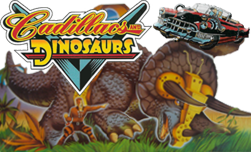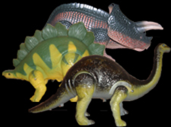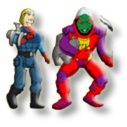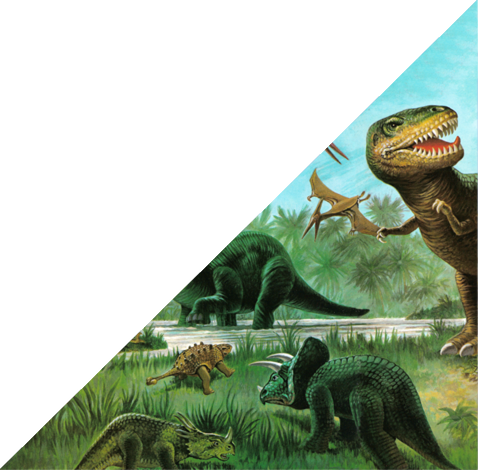











.png)








-1.png)
.png)







.png)












.png)


2.png)






























































































In 1990, shortly after the end of the Dino-Riders line, Tyco re-released some of
its dinosaur toys with the launch of its Smithsonian Institution line. Tyco actually
received an endorsement from the Smithsonian Institution, which was apparently impressed
enough with the technical accuracy of the sculpts that it was willing to license
its name for use on Tyco's products. The situation was great for Tyco because it
found itself with all these excess Dino-Riders that didn’t sell and all they had
to do was repackage them. The dinosaurs were basically the same as the Dino-Riders
except that no figures or weapons were included with them. They were sold individually
and in sets of two.
With some exceptions (see below), the Smithsonian toys were identical to their Dino-Rider
counterparts. It would have been really cool if Tyco had spent the extra time to
fully re-paint the dinosaurs, but maybe that was asking too much. In order to make
the toy line more accurate, a few name changes were made. The Quetzalcoatlus became
Pterodactylus, the Pterodactyl became Quetzalcoatlus, the Diplodocus became Apatosaurus
and the Ankylosaurus became Euoplocephalus. The Smithsonian line also added its own
Ice Age mammals, offering the Woolly Mammoth, Giant Ground Sloth and the Sabertoothed
Cat (no Killer Wart Hog).
A total of 18 dinosaurs/Ice-Age mammals were released. Some of the Tyco catalogs
that featured the Smithsonian Institution line showed several dinosaurs such as the
Saurolophus and the Chasmosaurus that were never actually released.






















.png)
.png)
.png)

.png)







.png)
.png)
.png)
.png)
.png)
.png)
.png)
.png)
.png)
.png)
.png)
.png)
.png)
.png)
.png)
.png)






.png)


.png)


Differences Between Smithsonian Institution and Dino-Riders Versions
Colors: For the most part, the Smithsonian toys are identical in color to their Dino-Riders
counterparts. The three exceptions to this rule are the Stegosaurus, Triceratops
and Giant Ground Sloth.
Appearance: With the exception of the Quetzalcoatlus and the Diplodocus, there are
no differences in the molds/physical appearance between the Smithsonian versions
and the Dino-Riders versions. Unlike the Dino-Riders Quetzalcoatlus, the Smithsonian
version (which was renamed Pterodactlyus) does not have a crest on its head. This
makes the piece highly sought after and it is a bit more difficult to find because
the Smithsonian line is generally not as common as the Dino-Riders line. The Smithsonian
version of the Diplodocus (which was renamed Apatosaurus) is less detailed than the
Dino-Riders version in that a lot of the ridge detail in the skin that is prominently
featured in the Dino-Riders version was smoothed away, giving it a much flatter appearance
overall.
.png)
Equipment Slots: Unlike most of the other Dino-Riders toys that used “belly-bands”
to secure their equipment in place, the Dino-Riders versions of the Styracosaurus
and the Monoclonius had notches on their sides that the harnesses would snap into.
Because the Smithsonian toys did not come with weapons or accessories, these notches
had to be filled in (after all, they were being marketed as scientifically accurate).
Motors: The toys that had motorized walking action in the Dino-Riders line no longer
had it in the Smithsonian line. The Smithsonian versions had their motors removed
and were therefore lighter than their Dino-Riders counterparts (the T-Rex was significantly
lighter because it had its motor and wheels removed). Also, the battery cases were
removed and smoothed over with plastic and the extra padding on the feet that helped
facilitate the walking were removed.
.jpg)
.jpg)
.jpg)
.jpg)
.jpg)
.jpg)
.jpg)
The Smithsonian Institution version of the Triceratops uses the same paint scheme
as the Dino-Riders Triceratops, except there are some subtle differences that become
noticeable when you compare them side by side. The Smithsonian Institution version
has a more washed out and less blended look than the Dino-Riders version.
The color scheme of the Smithsonian Institution version of the Giant Ground Sloth
is simpler and less detailed than the Dino-Riders version in that there are no black
stripes running across its belly and there are less black highlights on its face.
There are two different versions of the Smithsonian Institution Stegosaurus. The
first version has a paint scheme that is identical to the regular Dino-Riders Stegosaurus.
The second version looks very similar to the Dino-Riders version, except its plates
are painted all red instead of the two-toned red and gray in the Dino-Riders version.
.png)

.jpg)
.jpg)























.png)














.png)





-1.png)
.png)






.png)













































































.png)
.png)
.png)

.png)
.png)
.png)
.png)
.png)
.png)
.png)
.png)
.png)
.png)
.png)
.png)
.png)
.png)
.png)
.png)
.png)
.png)
.png)
.png)
.jpg)
.jpg)
.jpg)
.jpg)
.jpg)
.jpg)
.jpg)
.png)

.jpg)
.jpg)























.png)


